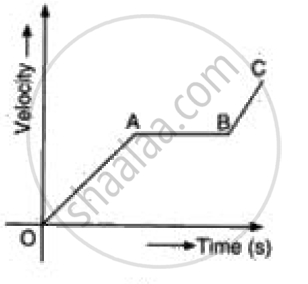Advertisements
Advertisements
Question
A toy car initially moving with uniform velocity of 18 km h-1 comes to a stop in 2 s. Find the retardation of the car in S.I. units.
Solution
initial velocity (u) = 18 km/h-1
final velocity (v) = 0 km/h
time (t) = 2 s
acceleration/retardation (a) = ?
To convert initial velocity u to m s-1
18 km/h-1 = `(18 " km")/(1 " h")`
= `(18 xx 1000 " m")/(60 xx 60 " s")`
⇒ 18 km/h-1 = `(18 xx 10 " m")/(6 xx 6 " s")`
⇒ 18 km/h-1 = 5 m s-1
Acceleration (a) = `("Final Velocity "("v") - "Initial Velocity "("u"))/("time "("t"))`
a = `(0 - 5)/2` m s-2
a = `-(5 "ms"^-1)/"2s"`
a = -2.5 m s-2
Hence, acceleration of the body is -2.5 m s-2. Negative sign shows that the velocity decreases with time, so retardation is 2.5 m s-2.
APPEARS IN
RELATED QUESTIONS
Give one example of the following motion:
Uniform retardation
If a body is moving with a constant velocity its acceleration is ______.
A motorbike, initially at rest, picks up a velocity of 72 kmh−1 over a distance of 40 m. Calculate
- acceleration
- time in which it picks up above velocity.
Define acceleration.
The acceleration of a moving body is constant in magnitude and direction. Must the path of the body be a straight line?
If not, given an example.
Interpret the following graph:
Correct your friend who says that acceleration gives the idea of how fast the position changes.
What do you mean by constant acceleration?
The slope of a velocity-time graph gives ______.
Acceleration is a scalar.
